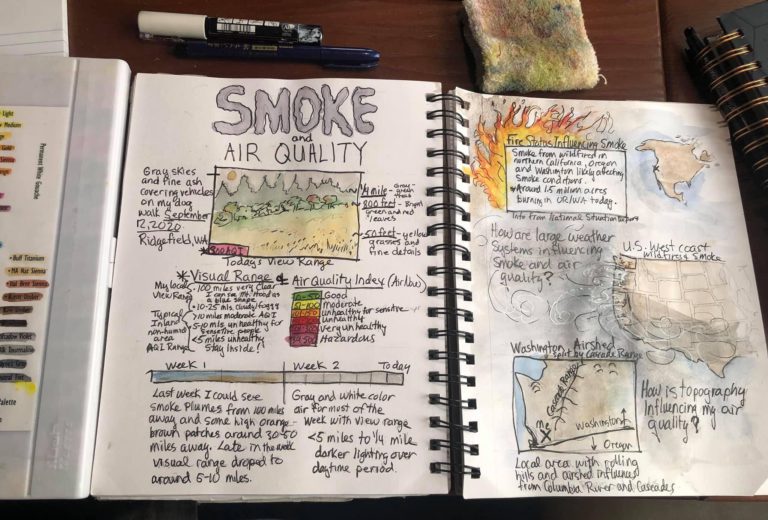
Hello! My name is Isabeau Ottolini, and I am one of the PyroLife Early Stage Researchers. As part of my PhD, I am exploring creative ways of communicating – on a community level – about wildfires, with the aim to foster a socioecological transformation towards Living with Fire.
Today we’re going to look at a great example: fire journaling. Inspired by nature journaling, this is a personal, place-based practice through which anyone can express their knowledges, observations, experiences, and curiosity surrounding wildfires.

By Miriam Morrill – Smoke & air quality during a fire
First things first: what is nature journaling?
Nature journaling is the practice of collecting on paper – through words, drawings, and numbers – observations, questions, connections, and explanations from the field.
There have been many historically famous nature journalers – like Charles Darwin (England), John Muir (USA), Frida Kahlo (Mexico), or Felix Rodríguez de la Fuente (Spain) – and nature journaling is becoming increasingly popular globally because:
Firstly, anyone can do nature journaling. The goal is not to create a masterpiece, but to be creative in your own unique way as you collect observations of the world around you. This can be in whichever format you like most, such as taking notes, making sketches, graphs or diagrams, writing poems, etc. And for this, you just need a pencil/pen and paper to start with, and some prompts like “I notice…, I wonder…, This reminds me of…”. Easy, right? (for more, see John Muir Laws website) .
Secondly, nature journaling is a practice with many, many benefits on the emotional, cognitive, sometimes even spiritual level: it helps you to slow down, increase your awareness and curiosity, and use all your senses to observe and analyze the world around you. It creates and deepens your sense of place, connecting both with the external world and yourself. It improves memory, understanding, and learning, as you pay attention to something through your senses and then put it on paper through a conscious act of creation.
Is it possible to nature journal about fire?
Yes, absolutely!! You can nature journal about anything and everything. So this, of course, also includes fires: wildfire, cultural burning and prescribed fires.
Here is a list of some great nature/fire journalers:
- Miriam Morrill: a US-based fire communicator and educator journaling about fire through PyroSketchology
- Paula Peeters: she does fire-related journaling in Australia
- Robin Lee Carlson: in her blog Wildfire to Wildflowers she journals the fire recovery after the Wragg Fire in 2015 (US)
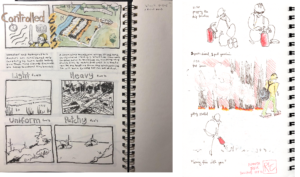
On the left: by Marley Piefer, before a controlled burn. On the right: by Robin Lee Carlson, during the Klamath Trex prescribed burn
- Marley Piefer: a nature journaler and an educator who integrates art with science.
- Laurie Wigham: she journals on the aftermath of wildfires in Sierra Nevada, USA, by using charcoal from the burnt sites.
- Don Hankins: a pyrogeographer at California State University, Chico, who makes sketches to accompany concepts covered in his pyrogeography classes.
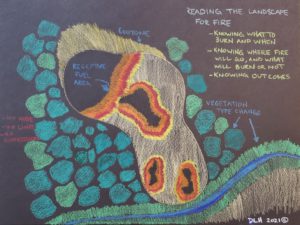
By Don Hankins – Pyrogeographer. “Reading the landscape is a work in progress related to Indigenous fire”
Why is fire journaling important?
Experiences with fire journaling show it is a powerful tool to use for fire communication and education. This is because fire journaling:
- is a place-based learning tool that is fully personalized and adaptive to the context. Whatever we observe and put on the paper, it is something that personally resonates with us, thereby making it a more profound learning experience.
- it stimulates sensory and full-bodied awareness, allowing for deeper ways of knowing and understanding. Through fire journaling, you learn to use your senses and observe. This is very important, for instance, to detect the day’s wildfire risk (smelling whether you detect smoke, observing daily changes in how dry the vegetation looks like, etc).
- makes it possible to map and share fire-relevant knowledge. This can be things like fire risk perception and preparedness, sense of place, and knowledges about the use of fire.
All in all, these characteristics make fire journaling a valuable practice for, amongst others, fostering fire adaptation and (re)framing fire narratives:
For wildfire adaptation, you need to be aware of what is happening around you, and understand why things happen in particular ways. Fire journaling can help, by focusing on a wide array of aspects before, during, and after a wildfire (check out this blog for more).
Personal, place-based observations on the full cycle of wildfires can create more diverse and richer narratives about fire, going beyond simplistic and negative framings of wildfires, informed largely by western, ‘expert’ voices. For instance, journaling about the socioecological and spiritual relationships with fire by peoples whose voices have long been excluded (such as indigenous communities).
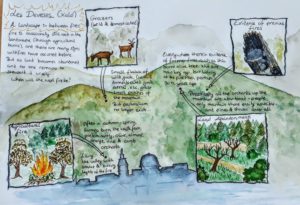
By Isabeau Ottolini. A landscape in between fires
How can I start with fire journaling?
Miriam Morrill has shared some great tips and considerations for anyone wanting to start with fire journaling.
First, a note of caution: many people have traumatic experiences and associations with wildfire. So, before starting fire journaling, it is important to assess your internal impressions of fire. If these emotions and impressions limit your interest and ability to journal about fire in nature, consider starting with a meditative practice. This can also help ground you in nature and increase your awareness.
Next, there are some basic Nature Journaling foundations:
- Find books, take workshops, network and practice! The more practice, the easier and better you get.
- Have a travel journaling kit that works for you. Do you carry a backpack when outdoors or do you want a pocket-sized journal and pen? Easy access is the key!
- Consider your journaling goals. Do you want to document your fire-related observations, learn or teach aspects of fire, or use it to create more expressive communications and art?
- Assess your fire journaling locations, timing, and safety considerations. Like any outdoor experience, you should be aware of the weather, environmental conditions, and any land access considerations.
Finally, some tips for fire journaling:

Image: Miriam Morrill – Pyrosketchology
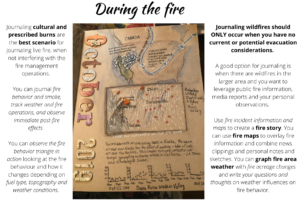
Image: Miriam Morrill – Pyrosketchology
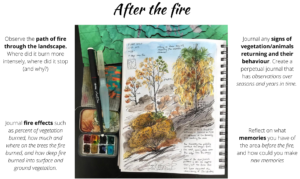
Image: Robin Lee Carlson – Anthropocene Sketchbook
Conclusion
Everyone can do fire journaling, and this turns it into a powerful, accessible practice for learning about wildfires, sharing experiences, and increasing our resilience in the face of wildfires.
If you want to read more, check out PyroSketchology, John Muir Laws, or The Nature Journal Club Facebook page. And on the 24th of May, Miriam Morrill will give a fire journaling session for the International Association of Wildland Fire conference.
While fire journaling is becoming more popular as a fire communication and education tool in places like the USA and Australia, in Europe it (seems) to not yet be a common practice. However, the many benefits of fire journaling would also be more than welcome in Europe, as we try to find ways to Live with Fire.
Do you know any fire journalers in Europe, or are you one yourself? It would be great to hear from you!

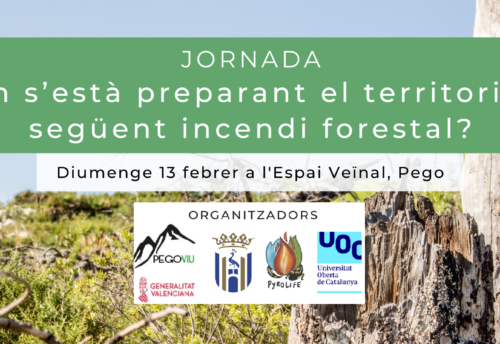
Well done, Isabeau! So inspired by all of these wonderfully creative people showcasing important social and ecological elements of wildland fire through their journaling.